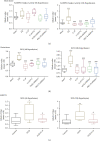Chlorpromazine and Promethazine (C+P) Reduce Brain Injury after Ischemic Stroke through the PKC- δ/NOX/MnSOD Pathway
- PMID: 35873710
- PMCID: PMC9307415
- DOI: 10.1155/2022/6886752
Chlorpromazine and Promethazine (C+P) Reduce Brain Injury after Ischemic Stroke through the PKC- δ/NOX/MnSOD Pathway
Abstract
Cerebral ischemia-reperfusion (I/R) incites neurologic damage through a myriad of complex pathophysiological mechanisms, most notably, inflammation and oxidative stress. In I/R injury, nicotinamide adenine dinucleotide phosphate (NADPH) oxidase (NOX) produces reactive oxygen species (ROS), which promote inflammatory and apoptotic pathways, augmenting ROS production and promoting cell death. Inhibiting ischemia-induced oxidative stress would be beneficial for reducing neuroinflammation and promoting neuronal cell survival. Studies have demonstrated that chlorpromazine and promethazine (C+P) induce neuroprotection. This study investigated how C+P minimizes oxidative stress triggered by ischemic injury. Adult male Sprague-Dawley rats were subject to middle cerebral artery occlusion (MCAO) and subsequent reperfusion. 8 mg/kg of C+P was injected into the rats when reperfusion was initiated. Neurologic damage was evaluated using infarct volumes, neurological deficit scoring, and TUNEL assays. NOX enzymatic activity, ROS production, protein expression of NOX subunits, manganese superoxide dismutase (MnSOD), and phosphorylation of PKC-δ were assessed. Neural SHSY5Y cells underwent oxygen-glucose deprivation (OGD) and subsequent reoxygenation and C+P treatment. We also evaluated ROS levels and NOX protein subunit expression, MnSOD, and p-PKC-δ/PKC-δ. Additionally, we measured PKC-δ membrane translocation and the level of interaction between NOX subunit (p47phox) and PKC-δ via coimmunoprecipitation. As hypothesized, treatment with C+P therapy decreased levels of neurologic damage. ROS production, NOX subunit expression, NOX activity, and p-PKC-δ/PKC-δ were all significantly decreased in subjects treated with C+P. C+P decreased membrane translocation of PKC-δ and lowered the level of interaction between p47phox and PKC-δ. This study suggests that C+P induces neuroprotective effects in ischemic stroke through inhibiting oxidative stress. Our findings also indicate that PKC-δ, NOX, and MnSOD are vital regulators of oxidative processes, suggesting that C+P may serve as an antioxidant.
Copyright © 2022 Sichao Guo et al.
Conflict of interest statement
The authors declare no conflict of interest.
Figures








Similar articles
-
An inhibitory and beneficial effect of chlorpromazine and promethazine (C + P) on hyperglycolysis through HIF-1α regulation in ischemic stroke.Brain Res. 2021 Jul 15;1763:147463. doi: 10.1016/j.brainres.2021.147463. Epub 2021 Apr 1. Brain Res. 2021. PMID: 33811844
-
Combining Normobaric Oxygen with Ethanol or Hypothermia Prevents Brain Damage from Thromboembolic Stroke via PKC-Akt-NOX Modulation.Mol Neurobiol. 2017 Mar;54(2):1263-1277. doi: 10.1007/s12035-016-9695-7. Epub 2016 Jan 28. Mol Neurobiol. 2017. PMID: 26820681
-
Crebanine ameliorates ischemia-reperfusion brain damage by inhibiting oxidative stress and neuroinflammation mediated by NADPH oxidase 2 in microglia.Phytomedicine. 2023 Nov;120:155044. doi: 10.1016/j.phymed.2023.155044. Epub 2023 Aug 21. Phytomedicine. 2023. PMID: 37634486
-
NOX Activation by Subunit Interaction and Underlying Mechanisms in Disease.Front Cell Neurosci. 2017 Jan 10;10:301. doi: 10.3389/fncel.2016.00301. eCollection 2016. Front Cell Neurosci. 2017. PMID: 28119569 Free PMC article. Review.
-
Which NADPH oxidase isoform is relevant for ischemic stroke? The case for nox 2.Antioxid Redox Signal. 2013 Apr 20;18(12):1400-17. doi: 10.1089/ars.2012.4721. Epub 2012 Aug 20. Antioxid Redox Signal. 2013. PMID: 22746273 Free PMC article. Review.
Cited by
-
Identification of key potassium channel genes of temporal lobe epilepsy by bioinformatics analyses and experimental verification.Front Neurol. 2023 Jul 7;14:1175007. doi: 10.3389/fneur.2023.1175007. eCollection 2023. Front Neurol. 2023. PMID: 37483435 Free PMC article.
-
CB1 Receptor Activation Provides Neuroprotection in an Animal Model of Glutamate-Induced Excitotoxicity Through a Reduction of NOX-2 Activity and Oxidative Stress.CNS Neurosci Ther. 2024 Nov;30(11):e70099. doi: 10.1111/cns.70099. CNS Neurosci Ther. 2024. PMID: 39496572 Free PMC article.
-
Manganese Superoxide Dismutase: Structure, Function, and Implications in Human Disease.Antioxidants (Basel). 2025 Jul 10;14(7):848. doi: 10.3390/antiox14070848. Antioxidants (Basel). 2025. PMID: 40722952 Free PMC article. Review.
References
MeSH terms
Substances
LinkOut - more resources
Full Text Sources
Medical
Research Materials

